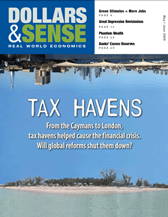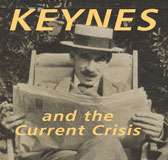The General Theory and the Current Crisis: A Primer on Keynes’ Economics
Intro | Pt. I | Pt. II | Pt. III | Pt. IV
Part I: Fiscal Policy and “Crowding Out”
This is a web-only article from the website of Dollars & Sense: The Magazine of Economic Justice available at http://www.dollarsandsense.org

This is a web-only article, available only at www.dollarsandsense.org.
Subscribe Now
at a 30% discount.

In response to the deepest recession in the United States since the Great Depression, the Obama administration proposed a large fiscal “stimulus” plan. (Fiscal policies involve government spending and taxation. A fiscal stimulus involves increases in government spending or tax cuts, or both.) The current stimulus plan, after some compromises between the Obama administration and Republicans in Congress, included both substantial tax cuts and increases in government spending. Together, they would increase the federal government deficit by over $700 billion.
A fiscal stimulus is a standard “Keynesian” response to a recession. The logic behind these policies is that recessions can be caused by insufficient total demand for goods and services. If saving (a “leakage” from demand) exceeds investment (an “injection” of demand), there will not be enough demand to buy all the goods and services that the economy is capable of producing at the “full employment” level. Some goods will go unsold, and firms will reduce output. They will cut jobs, cancel supply orders, and even close production facilities. The economy will spiral into a recession.
In standard Keynesian models, either tax cuts or increased government spending can increase total demand, and therefore total output and employment. An initial increase in spending (by either the government or the recipients of the tax cuts) results in new income for other individuals, who then go on to spend part (not all) of this income, which results in new income for still other individuals, and so on. Ultimately, this series of additions to income results in a total increase in GDP greater than the original increase in government spending or reduction in taxes. The increase in real GDP divided by the initial spending increase is called the “multiplier.” The standard Keynesian view implies a multiplier greater than one.
The Conservative Critique
Conservative economists, whose intellectual heritage includes decades-old attempts to refute Keynesian theory, disagree with this view. They argue that government spending cannot possibly increase overall economic activity, and that the stimulus plan is therefore doomed to fail. This position is sometimes known as the “Treasury view” (because it mirrors the arguments of the British Treasury Department during the Great Depression) or the theory of “crowding out.” The new government spending, these economists argue, “has to come from somewhere,” either from higher taxes or increased government borrowing. Either way, the increase in government spending will come at the expense of private spending.
If the spending is financed by tax increases, conservative economists argue, this will reduce individuals’ after-tax incomes and therefore reduce their spending. If it is financed through borrowing, the increased government demand for loans will drive up interest rates, and this will “crowd out” private investment. (Some private investment projects that would have been profitable at lower interest rates would not be profitable at the higher rates, and therefore would not be undertaken.) Extreme versions of this theory, known as “dollar-for-dollar” crowding out, argue that the decrease in private investment will exactly offset the increase in government spending, and there will be no change in the overall output of goods and services.
Government intervention is not only incapable of pulling the economy out of a recession, conservative economists argue, it is also unnecessary. If there is more saving than investment, the quantity of funds people are willing to loan out will exceed the quantity that people are willing to borrow at the current interest rate. The surplus of loanable funds will drive down the interest rate. People will save less (since the reward to saving is lower) and borrow more and invest more (since the cost of borrowing is lower), until the injection of investment and the leakage of saving are equal. In short, if insufficient demand ever caused a recession, the economy would quickly pull itself back to full employment without any need for government intervention.
Keynes’ Rejoinder
Keynes agreed with the idea that saving equals investment. In his view, however, this is true not only when the economy is producing at its full-employment capacity, but also when it is producing at far less than its capacity. Keynes argued that the “classical” economists (as he called the conservative orthodoxy of his time) had an incorrect view of the relationship between interest rates and savings, and that this was at the heart of their errors about the possibility of prolonged recessions.
The classicals believed that as interest rates increased, savings would increase, and that as interest rates declined, savings would decline. Keynes agreed that this was true at “a given income,” but that a change in the interest rate would also affect the amount investment and therefore the level of income. A higher interest rate, he argued, was associated with lower investment, lower incomes, and therefore lower saving; a lower interest rate, with higher investment, higher incomes, and therefore higher saving. (As people’s incomes increase, they spend more and save more; as their incomes decline, they spend less and save less.) In Keynes’ view, saving will equal investment whether investment and saving are both high (at or near the full employment level of output) or if investment and saving are both low (in a low-output, high-unemployment economy). In the latter case, Keynes believed, there was no guarantee that the economy would pull itself back to full employment.
Keynes was also well aware, long before his critics, that government borrowing could crowd out some private investment. In The General Theory itself, he noted that the effects of the government directly increasing employment on public works may include “increasing the rate of interest and so retarding investment in other directions.” This does not imply, however, dollar-for-dollar crowding out. Keynes still believed, and the empirical evidence confirms, that under depression conditions an increase in government spending can result in an increase in total output larger than the initial spending increase (a multiplier greater than one).
Of Spending and Multipliers
In a recent article in the Wall Street Journal, conservative economist Robert Barro declares, as a “plausible starting point,” that the multiplier actually equals zero. That’s what the dollar-for-dollar crowding-out theory means—an increase in government spending will be matched by equal decreases in private spending, and so will have zero effect on real GDP. When it comes to estimating the multiplier, based on historical data from 1943-1944, however, Barro finds that it is not zero, but 0.8.
First, contrary to Barro’s intent, this is actually a disproof of dollar-for-dollar crowding out. It means that increased government spending brought about increased real GDP, though not by as much as the spending increase. It increased the production of public-sector goods by (much) more than it reduced the production of private-sector goods. Unless one views private-sector goods as intrinsically more valuable than public-sector goods, this is not an argument against government spending.
Second, Barro chose to base his study on two years at the height of the U.S. mobilization for World War II. When the economy is at or near full employment, the multiplier is bound to be small. If all resources are already being used, the only way to produce more of some kinds of goods (say, tanks and war planes) is to produce less of some others (say, civilian cars). Keynesian economists certainly understand this. Their point, however, is that government spending creates a large multiplier effect when the economy is languishing in a recession, not when it is already at full employment.
Economist Mark Zandi of Moody’s Economy.com reports much higher multipliers for government spending. Zandi estimates multipliers between 1.3 and 1.6 for federal aid to states and for government infrastructure expenditures. The multipliers are even larger for government transfers (such as food stamps or unemployment compensation) to the hardest-hit, who are likely to spend all or almost all of their increase in income. Zandi estimates these multipliers at between 1.6 and 1.8. Tax cuts for high-income individuals and corporations, who are less likely to spend their additional disposable income, have the lowest multipliers—between 0.3 and 0.4.
Why the General Theory?
The conservative case against standard Keynesian fiscal stimulus policy rests on the assumption that all of the economy’s resources are already being used to the fullest. Keynes titled his most important work The General Theory because he thought that the orthodox economics of his time confined itself to this special case, the case of an economy at full employment. He did not believe that this was generally the case in capitalist economies, and he sought to develop a theory that explained this.The argument conservatives make against government spending—“it has to come from somewhere”—is actually no less true for private investment. If dollar-for-dollar crowding out were true, therefore, it would be just as impossible for private investment to pull the economy out of a recession. This, of course, would be nonsense unless the economy was already at full employment (and an increase in one kind of production would have to come at the expense of some other kind of production).
If the economy were already operating at full capacity—imagine a situation in which all workers are employed, factories are humming with activity 24/7, and no unused resources would be available to expand production if demand increased—the argument that increased government spending could not increase overall economic output might be plausible. But that is manifestly not the current economic situation.
Real GDP declined at an annual rate of 6.3% in the fourth quarter of 2008. The official unemployment rate surged to 8.5%, the highest rate in 30 years, in March 2009. Over 15% of workers are unemployed, have given up looking for work, or can only find part-time work. Employment is plummeting by more than half a million workers each month. A theory that assumes the economy is already at full employment can neither help us understand how we got into this hole—or how we can get out.
Did you find this article useful? Please consider supporting our work by donating or subscribing.
